Survey of Current Loading Techniques
Chip Densifier
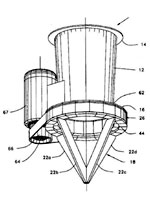
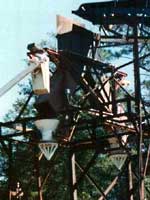
This Chip Densifier, with a patent-date of 1998 has been used for loading chips into ocean-going vessels and railroad cars. The motor (on the left-side) rotates the bottom "V" section as chips pass through, as shown on the public-access patent drawing at the near right.
Several chip car users report payload gains in the 4-8 percent range.
At the far right, a pair of densifiers is visible over a single rail track. Extensive shielding is required, but not yet built here, to control spillage over the car sides. Users state that this device requires "lots" of operating and maintenance attention.
Blower Chip Accelerator
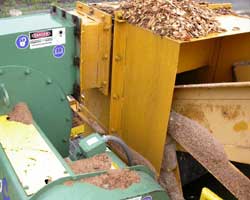
Car-loading systems using blowers connected to the chute-work above the car have been used in a handful of locations.
This is obviously NOT to be confused with pneumatic blow-pipe systems used as a means to get the chips to the car in the first place.
With this particular methodology, a blower sends air down the loading chute to accelerate chip-velocity into the car.
User reports indicate that weight gains are perhaps 1-2 tons with no certainty of those figures.
Loading Wing Walls
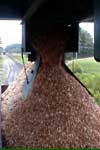
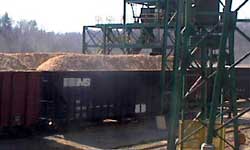
For those rare situations where cars are all the same height, wing walls work well to form chips into a steep pile above the car much like a curb forming machine.
The payload difference between a level-full car and a peaked-up car can exceed ten tons, especially with 66-foot long cars like these.
Car Shaker
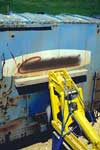
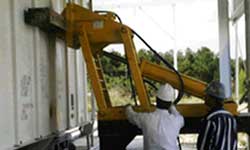
As old-timers may remember, car shakers were once used to shake chip cars while being loaded. The theory has merit. All one has to do is compare the chip height of departing cars to that of arriving cars after as little as 100 miles of travel to see 3-4 feet of settlement of chips in cars.
Lots of compressed air is needed for these shakers. High-capacity compressors supply large surge air tanks to provide adequate air volume for the intermittent car-shaking exercise. When operating, these shakers generate a notorious noise-level!
The operating and maintenance cost of these systems to achieve a 2-3 percent loading gain was generally determined to NOT be cost-effective. No shaker system is known to currently be in-use for loading chips.

